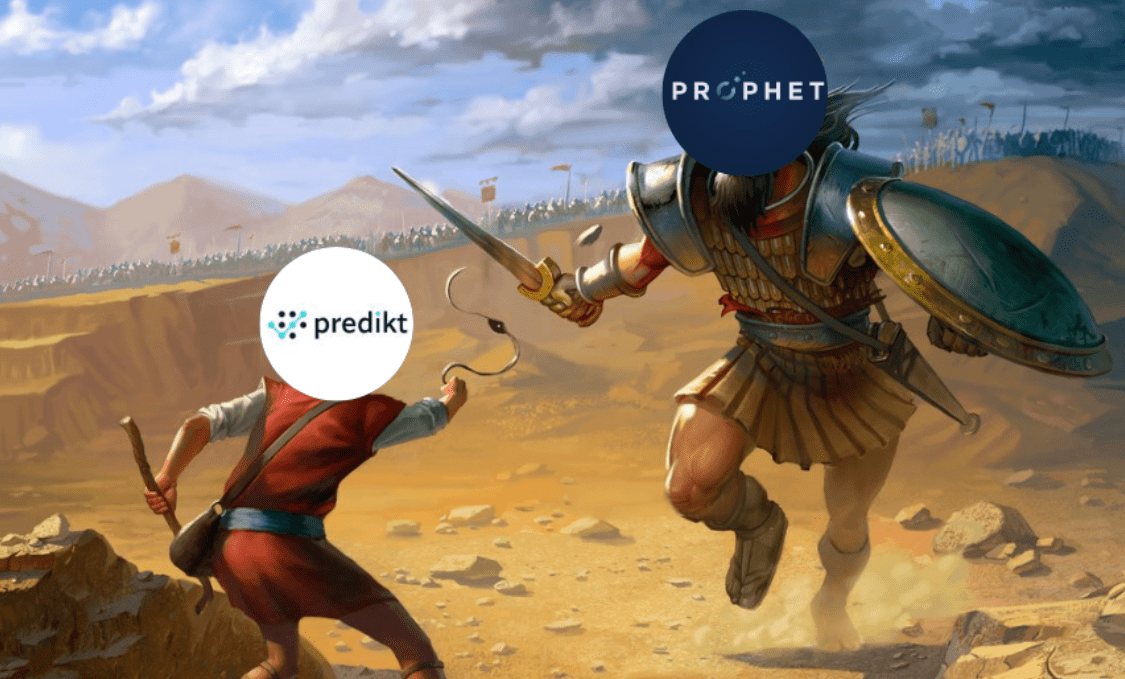In today’s fast-paced and complex business landscape, the ability for businesses to make informed decisions rather than relying on intuition is crucial. It allows for proactively mitigating risks, optimizing operations and anticipating changes. With predictive analytics, models can be learned by exploiting business data. With these models, predictions can be generated for specific KPIs, providing valuable insights. The model choice is imperative for the accuracy of the predictions and the quality of the learned insights. This article compares open-source models such as Prophet with Predikt’s proprietary core twin model, highlighting why Predikt’s solution offers superior performance for complex environments and questions.

Real-World Application: Wage Costs in Farming
Consider a farming business where the total wage cost is the sum of full-time employees (FTEs) and seasonal workforce costs. Each cost component consists of a price multiplied by a volume, influenced by external factors like inflation and weather. Open-source models can model this scenario using a weighted sum, but they may miss the multiplicative relationships critical for accuracy.
Predikt, on the other hand, automatically identifies the relevant inflation and weather indicators, incorporates the appropriate lead times, and learns the correct multiplicative relationships. The price components will be impacted by external indicators like inflation, while the seasonal volume components will be impacted by external variables related to certain weather conditions. The wage cost can then be modeled using the following formula:
fte_price x fte_volume + seasonal_price x seasonal_volume
=
base_price*inflation x fte_volume + base_price*inflation x base_volume*weather forecast
Introduction into Prophet
Prophet is an open-source tool specifically designed to handle time series data with daily, weekly or monthly observations and can capture various complex patterns, including trend changes, multiple seasonal effects and holidays. It is particularly effective with business time series data, which often exhibits distinct seasonal and holiday effects. Therefore, Prophet consists of a weighted sum containing a trend, seasonality, holiday and error component alongside additional components for each additional variable. Little manual effort is required to get reasonably accurate forecasts on noisy data as it handles outliers and missing data internally. It also allows the addition of domain knowledge to improve the forecasts by allowing users to specify custom seasonalities, holidays, and control the flexibility of the trend through human-interpretable parameters. Additional variables can also be added that might influence the time series. For instance, inflation for the FTE price and the weather forecast for the seasonal volume of the seasonal workforce.
After training, the model provides clear insights about each component by providing their individual contributions to the generated predictions. This way, an in-depth impact analysis can be performed, generating meaningful insights.
The output of a Prophet model
Predikt’s Core Twin Model: A Superior Alternative
The Predikt core twin model is a cutting-edge forecasting model developed by Predikt. It is a highly versatile model designed to learn any formula by combining a data-driven approach with an automatic approach to logically select the impacting variables. As with Prophet, each trend, seasonality and external variable component provides its individual contribution to the generated predictions. There are two main areas where Predikt excels compared to Prophet.
- Before the model training, Predikt automatically selects and preprocesses highly relevant indicators from a large indicator database.
- During the model training, it is capable of learning any formula for a specific target KPI, allowing it to capture intricate, real-world behavior.
Selecting impacting variables
Prophet does not examine whether the relationships it finds make sense from a business point of view. It could build a model using a highly correlating inflation indicator from a completely irrelevant industry. Predikt automatically selects a handful of highly relevant indicators from a database of millions of searchable indicators. This allows Predikt to build a model with variables that have a logical predictive relationship with the specified KPI to be predicted. For instance, external indicators specifically related to farming should be added instead of highly correlating illogical indicators. To build robust and trustworthy models it is imperative to connect variables that correlate as well as causate, as is stated in this previously written article.
Searching external indicators
Predikt allows its users to search through its extensive indicator database of more than one million external indicators. All indicators come in a standardized and explainable format ensuring the correctness and interpretability of the data. This eliminates several weeks of upfront work that was previously required by our clients before using Predikt. Users maintain the flexibility to supply custom drivers that they already possess to the model.
Automated lead-time analysis
As seen in the running example, many business problems are influenced by leading economic indicators. If inflation rises, a certain amount of months later the wages and salaries of employees tend to also rise. Predikt natively incorporates automated lead-time analysis. It does this by utilizing causally relevant lead times to find the optimal lead times for the external indicators. In Prophet, users would need to manually shift each time series for the desired range of possible lag times, increasing the manual effort significantly.
Model bias
Prophet’s model is represented by a weighted sum, while Predikt’s model can be any formula. As shown using the running example, many real-world phenomena cannot be represented by only using a weighted sum, but need also to include multiplicative relationships. Learning models with limited complexity, like Prophet, will result in underperforming models. This can be omitted by allowing complex formulas to be learned. However, this significantly increases the risk of finding spurious correlations as there is limited data available to train on and many external variables to choose from. This will produce meaningless models containing logically invalid predictive relationships. By using causally selected variables in a certain business context, it is possible to create meaningful models that incorporate the required complexity to capture valuable data-driven and logical insights from business data.
Conclusion
While open-source models like Prophet solutions are valuable tools for quick tests and simple scenarios, they fall short in complex environments requiring nuanced, data-driven insights. Predikt’s core twin model offers a robust alternative, with automatic variable selection, comprehensive indicator access, automated lead-time analysis, advanced model complexity, and intelligent time series routing. By leveraging Predikt, businesses can achieve more accurate, reliable, and actionable predictions, empowering them to make better-informed decisions in today’s challenging business landscape.




